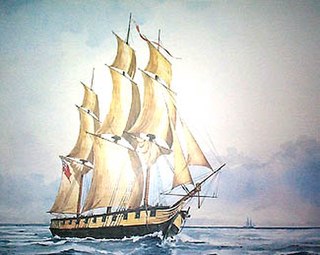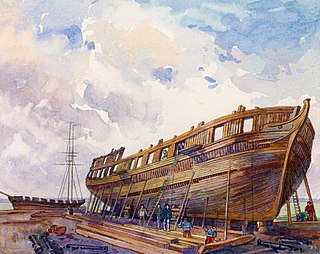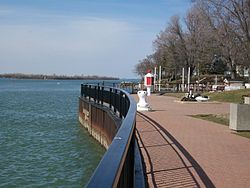
HMS Detroit was a 20-gun sloop of the Royal Navy, launched in July 1813 and serving on Lake Erie during the War of 1812. She was the most powerful British ship in the Lake Erie squadron until the Americans captured her during the Battle of Lake Erie on 10 September 1813. Detroit was commissioned into the United States Navy as its first USS Detroit. However, she was so damaged that the sloop took no further part in the war. Postwar, Detroit was sunk for preservation at Misery Bay off Presque Isle until 1833, when she was refloated and converted for commercial service. In 1841, Detroit was reduced to a hulk at Buffalo, New York where she was purchased with the intent of sending her over Niagara Falls. The plan went awry and Detroit ran aground on a shoal before the falls and broke up.

Detroit was a 6-gun brig launched in 1798 as Adams in the United States. During the War of 1812 the British captured her, renamed her, and took her into the Provincial Marine. She served on Lake Erie during the War of 1812, giving the British control of the lake. The Americans briefly recaptured her, but she grounded and came under heavy fire. The Americans had to abandon her. The vessel was set afire and burnt.

USS Niagara, commonly called the US Brig Niagara or the Flagship Niagara, is a wooden-hulled snow-brig that served as the relief flagship for Oliver Hazard Perry in the Battle of Lake Erie during the War of 1812. As the ship is certified for sail training by the United States Coast Guard, she is also designated SSV Niagara. Niagara is usually docked behind the Erie Maritime Museum in downtown Erie in the U.S. state of Pennsylvania as an outdoor exhibit for the museum. She also often travels the Great Lakes during the summer, serving as an ambassador of Pennsylvania when not docked. It was listed on the National Register of Historic Places in 1973 and was designated the official state ship of Pennsylvania by the Pennsylvania General Assembly in 1988.
USS Caledonia was a brig, formerly HMS Caledonia, that the United States Navy captured during the War of 1812 and took into American service. The brig played an important role with the American squadron on Lake Erie, and was sold at the end of the war.

HMS Royal George was a British 20-gun wooden sloop of the Provincial Marine, and subsequently, the Royal Navy, operating on Lake Ontario during the War of 1812. The vessel took part in several Engagements on Lake Ontario and was the flagship of the Provincial Marine at the First Battle of Sackett's Harbor. In 1814, the vessel was renamed Niagara. Following the war, the sloop was converted to a transport and sold in 1837.

HMS Duke of Gloucester was a 10-gun brig of the Royal Navy which was launched at the Kingston Royal Naval Dockyard in Kingston, Ontario. A Provincial Marine vessel, during the War of 1812, the brig took part in several of the early engagements between British and American naval forces on Lake Ontario and the St. Lawrence River. While being repaired at York, Duke of Gloucester was captured by Americans in 1813. A month later the British destroyed the brig at the Battle of Sackett's Harbor.
Nancy was a schooner, built in Detroit, Michigan and launched in 1789. She served for several years in the fur trade on the Great Lakes, but is best known for playing a part in the Anglo-American War of 1812. She served for several years as a vital supply ship for the Provincial Marine. The Royal Navy took over the Provincial Marine in 1814 and so acquired Nancy. After HMS Nancy was blocked in by an American fleet near the mouth of the Nottawasaga River, her crew set her on fire on 14 August 1814 to prevent the capture of the ship and the cargo she carried. Forgotten for many years, the wreck was re-discovered in July 1927 and raised to form the centrepiece of the Nancy Island Museum.

HMS Princess Charlotte, later HMS Burlington, was a 42-gun fifth-rate frigate of the Royal Navy built in 1814, during the War of 1812 at the Kingston Royal Naval Dockyard in Kingston, Ontario. She had originally been built as Vittoria, but was renamed before being launched. She was constructed to a design by George Record, and was built under a private contract by Master shipwright John Goudie. She served on Lake Ontario, having been commissioned at Oswego on 5 May 1814 under Captain William Mulcaster.

HMS Psyche was a 54-gun fourth-rate frigate of the Royal Navy. She was built at the Kingston Royal Naval Dockyard in Kingston, Upper Canada during the War of 1812, using frames shipped from Britain and assembled in Upper Canada. The ship was not completed until after the end of the war in 1815 and did not enter service. Under the Rush–Bagot Treaty of 1816, the frigate was disarmed and laid up at Kingston. The ultimate fate of the ship is unknown.

The Kingston Royal Naval Dockyard was a Royal Navy Dockyard from 1788 to 1853 in Kingston, Ontario, Canada, at the site of the current Royal Military College of Canada.
Navy Island Royal Naval Shipyard was a Royal Navy yard in Ontario.

The Naval Shipyards were naval shipbuilding facilities used by the Provincial Marine and the Royal Navy in York, Upper Canada. The naval shipyards were ordered by the Lieutenant Governor of Upper Canada John Graves Simcoe in 1793, and were opened in 1798.
HMS Prince Regent was a 56-gun British warship that served on Lake Ontario during the War of 1812. Prince Regent was built at the Kingston Royal Naval Dockyard in Kingston, Upper Canada and launched on 14 April 1814. Rated as a fourth-rate frigate, Prince Regent took part in the Raid on Fort Oswego in 1814. Following the War of 1812 the frigate was renamed HMS Kingston on 9 December 1814. In 1817, the vessel was placed in reserve following the Rush-Bagot Treaty that demilitarized all the lakes along the United States-Canada border. Discarded in 1832, the vessel found no buyer and sank in Deadman Bay off Kingston after 1832.
HMS Moira was a British 14-gun schooner of the Royal Navy, that plied the waters of Lake Ontario and the St. Lawrence River during the War of 1812. Initially constructed for the Provincial Marine in 1805, the vessel took part in the Engagements on Lake Ontario. Renamed Charwell in 1814, following the war, the vessel became a powder hulk and an accommodation vessel. The vessel was sold in 1837.
HMS Lord Melville was a brig of the Royal Navy launched at Kingston, Ontario, on 20 July 1813. Initially designed as a schooner, she was altered to 14-gun brig in 1813. She served on Lake Ontario during the War of 1812, and was renamed HMS Star on 22 January 1814. By 1815, she was unfit for anything but transport duties. She was sold in 1837.

Provincial Marine was a coastal protection service in charge of the waters in the Great Lakes, the St. Lawrence River and parts of Lake Champlain under British control. While ships of the Provincial Marine were designated HMS, they were operated in more of a coast guard manner than as a full-fledged navy. Operations were maintained and staffed by the Royal Navy. Most ships of the Provincial Marine were built on the Great Lakes.
USS Lady Prevost was a schooner captured from the British during the War of 1812 and pressed into use in the United States Navy.
HMS General Hunter was a 10-gun brig of the Upper Canada Provincial Marine then, in 1813, the Royal Navy for their squadron on Lake Erie. She was ordered and built as a schooner in 1806 to replace Hope, a Provincial Marine vessel that had run aground in 1805. General Hunter was launched in 1807, entering service that year. With the outbreak of the War of 1812, General Hunter was converted to a brig and rearmed. As part of the Lake Erie squadron, General Hunter was present at the Battle of Lake Erie where the United States Navy defeated the British and gained control of the lake. General Hunter was captured at the battle and taken into American service. With the ship's name shortened to Hunter, she was used as a transport for the rest of the war. Following the war, the ship was sold into mercantile service. In 1816, the ship ran aground in a storm on Lake Huron and wrecked. The ship's contents were salvaged, but the wreck was left to be buried under the sand. In 2004, the wreck became the site of archaeological excavations and artifacts were retrieved from the site and placed in museums.
Queen Charlotte was the ship-rigged ship-sloop constructed for the Upper Canada Provincial Marine in 1810 as part of the fleet renewal in the lead-up to the War of 1812. Ordered in 1809, the ship was designed by Master Shipwright William Bell and constructed at Amherstburg Royal Naval Dockyard in Amherstburg, Upper Canada on Lake Erie. The design was based on the Snake class and was considered an effective design. During the War of 1812, Queen Charlotte was part of the Lake Erie squadron. After the Royal Navy took over command of the Great Lakes, Queen Charlotte was commissioned in 1813. On 10 September 1813, Queen Charlotte and the rest of the Lake Erie squadron were captured at the Battle of Lake Erie. The ship entered service with the United States Navy, though after the defeat of the British squadron, saw no further action during the war. Following the war, the ship was intentionally sunk at Put-in-Bay for preservation. Raised and sold into commercial service in 1825, the vessel continued in service until 1844, when the ship was no longer considered serviceable and left to rot as a dismasted hulk.
Prince Regent was a schooner constructed for Upper Canada's Provincial Marine for use on Lake Ontario. Built just before the beginning of the War of 1812, the vessel took part in the attack on Sackett's Harbor, New York. With the arrival of the Royal Navy in the Great Lakes under the command of Commodore James Lucas Yeo in 1813, the vessel was renamed HMS Lord Beresford or General Beresford, or Beresford. The British detachment on the lake engaged the American naval squadron and attacked American positions in the Niagara region, while supporting British armies.










